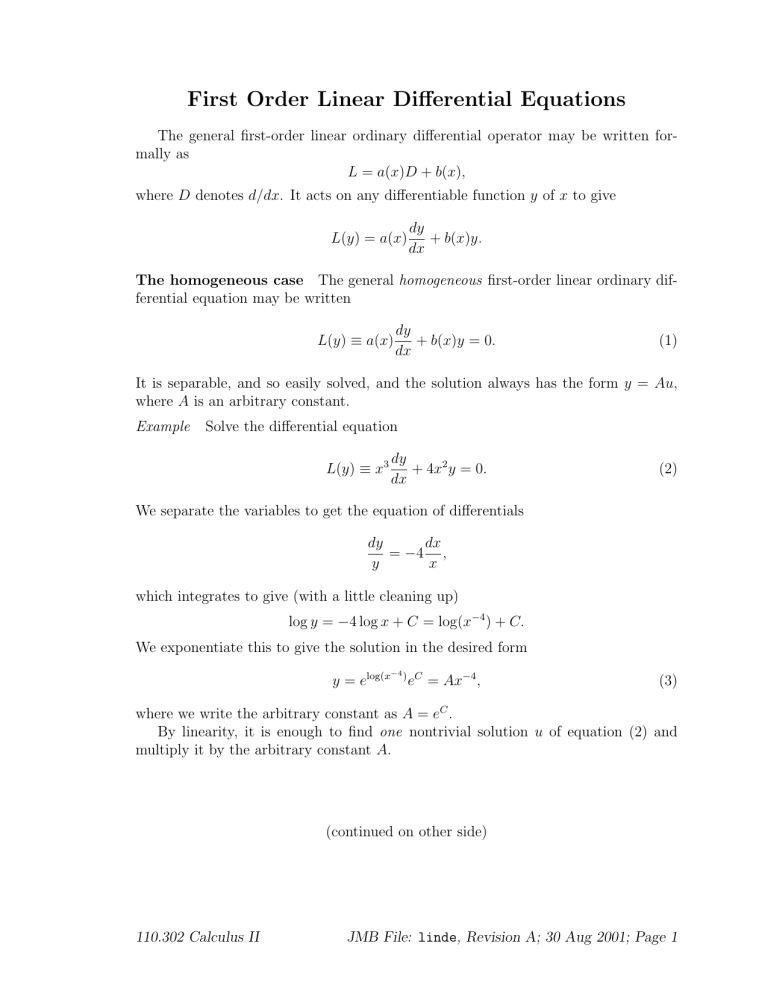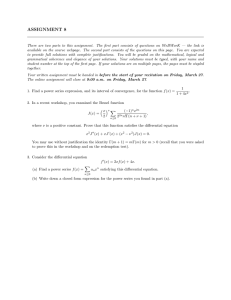First Order Linear Differential Equations
advertisement

First Order Linear Differential Equations The general first-order linear ordinary differential operator may be written formally as L = a(x)D + b(x), where D denotes d/dx. It acts on any differentiable function y of x to give L(y) = a(x) dy + b(x)y. dx The homogeneous case The general homogeneous first-order linear ordinary differential equation may be written L(y) ≡ a(x) dy + b(x)y = 0. dx (1) It is separable, and so easily solved, and the solution always has the form y = Au, where A is an arbitrary constant. Example Solve the differential equation L(y) ≡ x3 dy + 4x2 y = 0. dx (2) We separate the variables to get the equation of differentials dx dy = −4 , y x which integrates to give (with a little cleaning up) log y = −4 log x + C = log(x−4 ) + C. We exponentiate this to give the solution in the desired form y = elog(x −4 ) eC = Ax−4 , (3) where we write the arbitrary constant as A = eC . By linearity, it is enough to find one nontrivial solution u of equation (2) and multiply it by the arbitrary constant A. (continued on other side) 110.302 Calculus II JMB File: linde, Revision A; 30 Aug 2001; Page 1 2 First Order Linear Differential Equations The nonhomogeneous case The general nonhomogeneous first-order linear ordinary differential equation may be written L(y) ≡ a(x) dy + b(x)y = Q(x). dx (4) We use the method of variation of parameter(s). The idea is to put y(x) = A(x)u(x), where u is a solution of the corresponding homogeneous equation equation (1), except that the parameter A is now allowed to vary. By the product rule, L(y) has some terms with A(x) as a factor, and some terms with A0 (x) as a factor. The point is that the terms with A must cancel, because L(Au) = 0 if we choose A to be constant, by our choice of u. (This provides a useful check on our calculations.) Then equation (4) reduces to an equation for A0 (x), which is to be integrated to give A(x) and hence the general solution y. Example Solve the differential equation L(y) ≡ x3 dy + 4x2 y = x − 1. dx (5) In view of equation (3), we put y(x) = A(x)x−4 . Then L(y) = x3 A0 (x)x−4 − 4x3 A(x)x−5 + 4x2 A(x)x−4 = A0 (x)x−1 . Observe that the terms with A(x) cancel. Thus equation (5) reduces to A0 (x) = x(x − 1), which integrates to give A(x) = x3 /3 − x2 /2 + C. The general solution of equation (5) is therefore y= A(x) 1 1 C = − 2 + 4, 4 x 3x 2x x (6) where C is the arbitrary constant. 110.302 Calculus II JMB File: linde, Revision A; 30 Aug 2001; Page 2


